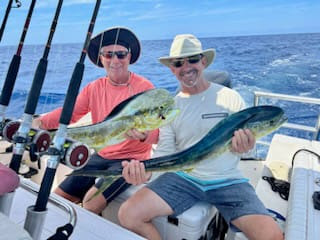Mother Nature Has Spoken!
After our return from the Bahamas, we spent a month in Jensen Beach Mooring field, where we could visit my parents and Steve's, take care of the typical appointments, visit with friends, and provision for our journey back to the Chesapeake.
I ended up contracting COVID, which hampered my ability to see everyone as I had hoped, but fortunately my case was mild, and I recovered in time to take a road trip to see Bridgette in Charleston. I actually got to see Bridgette play volleyball for the first time in 3 years, and was thrilled to meet some of her volleyball friends.
 |
| Bridgette and Laura in Charleston |
 |
| Steve and Ed with Catch of the Day - Mahi |
 |
| Today's Catch: Mahi and Wahoo! |
One big difference in this stop at home port was that we didn't have any big boat projects to do. Hurray!! We had a few minor maintenance items to attend to, as is the way with boats, but these were addressed quickly, and we found ourselves itching to be on the move again after a few weeks. The timing was just about right anyway, since we needed to be north of the Florida state line by July 1st.
We made our last rounds of visits, returned my parents' car (very gratefully) and set sail for an overnight journey to St. Augustine on June 13th. We were sailing downwind, and the winds were light - less than 10 knots - so we raised the spinnaker. Unfortunately, the windspeed dropped as the afternoon wore on, leading to our key learning on this particular sail: 5 knots is too light and the spinnaker collapses upon itself at that windspeed. We therefore stowed the spinnaker, and motor-sailed for the rest of the afternoon. Steve and I were disappointed since running the motors spoils the peacefulness that is one of the beauties of sailing. Some of my sea creature friends, turtles and dolphins, took turns making the trip more enjoyable by keeping us company along the way. As evening approached, the winds picked up and we were able to sail, sans motors. Since the winds were still fairly light, our speed was much slower than anticipated though, and by morning, we realized that we wouldn't make it to Saint Augustine before dark. This meant a unscheduled stop at New Smyrna, but no matter...that's part of this gig.
We found a nice anchorage, rested, and checked the weather forecast for the next day. Another day of light, but sailable, winds was in store so we set our anchor alarm and went to bed early. About 1:10 am, we heard from Mother Nature, LOUDLY! Steve and I were woken from deep sleep to what I thought was the sound of a freight train going past our boat. But no....it was just the wind, gusting up to 40 knots or so! Out of nowhere. I checked the weather app to see what I had missed, but found only a severe weather alert that had been issued at 1:00 am. Huh?!?
Thankfully our anchor is a good one, and we had no issues other than being surprised, but that was our first indication that the typical Florida thunderstorms have upped their game. Twenty-five knots, sure, but forty??
By the next morning, the weather was sunny and the winds were light, just as predicted. After our requisite trip to shore with the salty dog, Jake, we raised the mainsail and the spinnaker and set sail for Saint Augustine (again). The wind was variable, in both speed and angle to the sail, making it a bit difficult to keep the spinnaker loaded properly. Steve and I were both eating lunch, as well as watching the sails and the wind instruments, and after the spinnaker collapsed and refilled several times, I realized that the wind gusts were quite a bit higher than just a few seconds before. I dropped my sandwich and said, "I think we better douse the spinnaker right now!" and then heard it rip. The wind had dropped to 7 knots, the spinnaker collapsed and then a 17 knot gust caused a tear right down the upper, middle section of the spinnaker. 😒Lesson number 2: spinnakers are very delicate.
We meanwhile had started watching the weather radar to keep an eye on fast moving thunderstorms in light of the previous night's event and saw that there was a very large weather system, moving from the west across the upper part of Florida. It was projected to remain north of Saint Augustine and to have passed by the time we arrived there. I also checked all of the coastal towns we would be passing en route to see if there were any severe weather alerts. Everything looked good, and we were pretty much halfway to St. Augustine at this point. There are no inlets between Ponce Inlet, from where we had departed that morning, and our destination inlet at St. Augustine so we decided not to turn around. It would've been an uncomfortable passage back anyway, because we would have been heading upwind.
We continued to motor-sail that afternoon, and eventually lowered the mainsail when the winds dropped to 4.5 knots. Around 4 pm, the wind started to pick up and clouds started rolling in. By 4:30 pm, we were in the middle of a seemingly never-ending squall, with winds anywhere from 25 to 42 knots. This lasted four hours!! What we would learn later, was that the storm system that was projected to head east took a southeast trajectory instead.
 |
| Weather radar at 1:22 pm shows the storm moving eastward, staying well north of Saint. Augustine |
 |
| Radar at 9:15 pm shows the storm as far south as Daytona |
 |
| View of Fort Mantanzas, St. Augustine from Starry Night |



Comments
Post a Comment